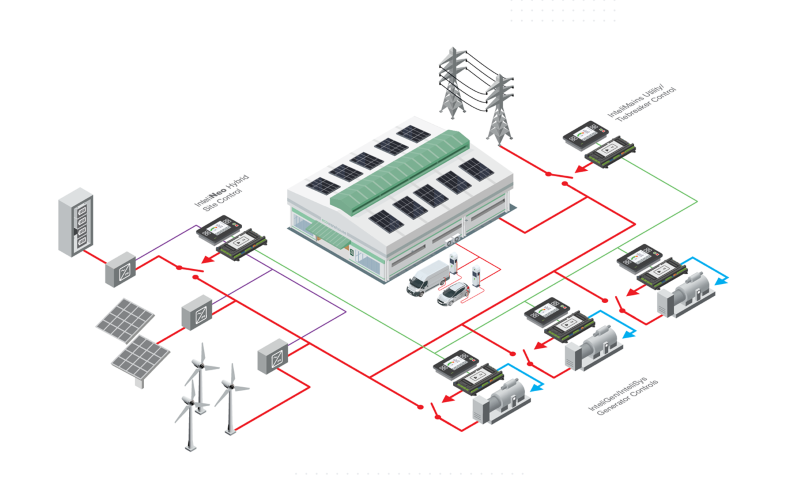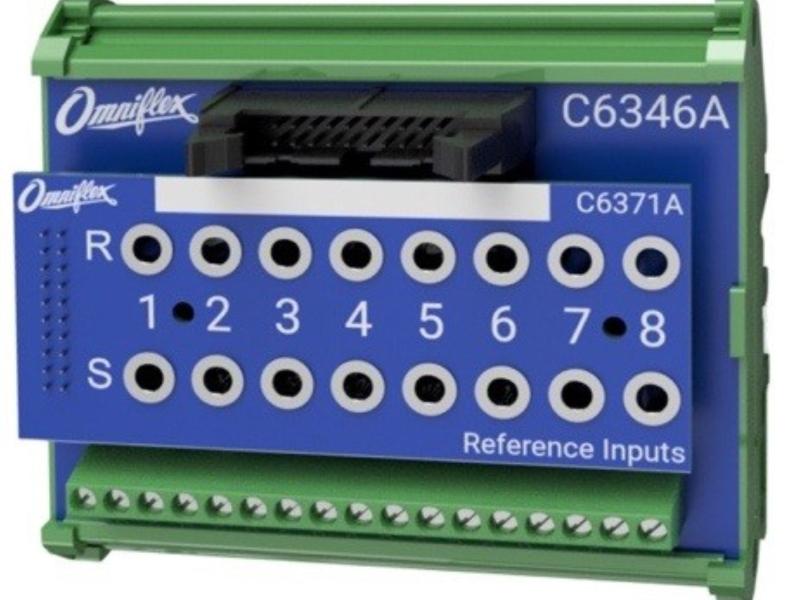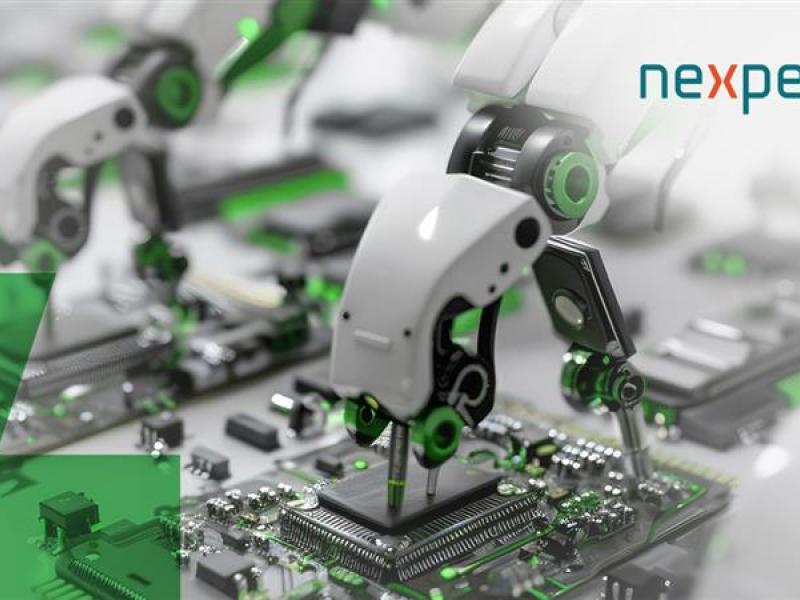A microgrid is a small-scale power grid that can operate independently (island mode) of the mains and in conjunction with the grid (grid mode) to supply backup or supplementary power. Any small-scale, localised power station that has its own generation and storage resources and definable boundaries can be considered a microgrid – such as any power station on any island around the world.
Microgrids are becoming increasingly popular because of the rapid rise in power demand due to industrial growth. In many locations, the current mains grid system cannot cope with increased power demands. That´s why businesses, governments, and industries have begun to resort to generating their own power to ensure reliability and gain more control over rapidly rising electricity prices.
1) Why has it become such a hot topic?
Microgrids offer a dynamic and adaptable approach to energy management, addressing critical challenges faced by traditional grids. Their ability to enhance grid stability, promote renewable energy, and ensure reliable power supply has positioned them at the forefront of energy discussions worldwide.
The prominence of microgrids as a hot topic can be attributed to several key factors:
a) Energy Transition and Decentralisation:
• As the world shifts toward cleaner energy sources and aims to reduce reliance on fossil fuels, microgrids offer a decentralised alternative. They empower local communities, businesses, and institutions to generate their own energy sustainably.
• Microgrids align with global efforts to combat climate change by promoting renewable energy adoption and reducing greenhouse gas emissions.
b) Resilience and Reliability:
• Increasingly frequent extreme weather events, natural disasters, and cyber threats highlight the vulnerability of centralised power grids. Microgrids provide a resilient solution by operating independently during grid failures.
• Critical facilities such as hospitals, military bases, and emergency response centres rely on microgrids to maintain essential services during disruptions.
c) Advancements in Technology:
• Innovations in energy storage, smart grid management, and control systems have made microgrids more efficient and cost-effective.
• Battery storage, for instance, allows microgrids to store excess energy from renewables and release it when needed, enhancing grid stability.
d) Energy Access in Remote Areas:
• Microgrids play a crucial role in providing electricity to remote and underserved regions. These areas may not have access to the main grid, making microgrids a lifeline for communities and businesses.
e) Economic Benefits:
• Microgrids can reduce energy costs by optimising local generation and consumption. Businesses and industrial complexes benefit from lower electricity bills.
• In some cases, excess energy generated by microgrids can be sold back to the main grid, creating revenue streams.
f) Policy and Regulatory Support:
• Governments and regulatory bodies recognise the importance of microgrids in achieving energy security and sustainability.
• Incentives, grants, and favourable policies encourage investment in microgrid projects.
g) Demonstration Projects and Success Stories:
• High-profile microgrid installations, successful pilot projects, and case studies have raised awareness and demonstrated the feasibility of microgrids.
• Notable examples include military bases, university campuses, and industrial parks adopting microgrid solutions.
2) What is a hybrid system?
A hybrid microgrid system is a collection of interlinked renewable and conventional energy resources connected to users and controlled by systems to ensure efficient energy usage and storage. Hybrid microgrid systems combine the best of renewable and conventional energy sources, ensuring a sustainable, reliable, and economically viable energy solution for diverse applications.
Remote places such as islands or mines are often located outside of the national electricity grid reach and therefore, have to use their own microgrids to generate electricity. However, with the changing landscape, micro-grids are increasingly being integrated into existing grid-supplied systems due to increasing load demand. Our current grid infrastructure cannot be upgraded fast enough, and the cost is so huge that a much more affordable method is to bring the source of generation closer to the area of demand, i.e., installing a microgrid system where there is a power demand.
Let’s delve deeper into the components and benefits of hybrid microgrids:
A. Components of a Hybrid Microgrid:
• Renewable Energy Sources: These include solar photovoltaic (PV) panels, wind turbines, hydro and other sustainable energy generators.
• Conventional Energy Sources: These may involve diesel generators, natural gas, or other non-renewable power sources.
• Energy Storage Systems (ESS): Batteries or other storage technologies store excess energy for later use.
• Control Systems: Advanced control algorithms manage the flow of energy, optimise generation, and balance supply and demand.
• Users: Residential, commercial, or industrial consumers connected to the microgrid.
B. Key Features and Benefits:
• Efficient Energy Usage: Hybrid microgrids intelligently switch between renewable and conventional sources based on demand, availability, and cost. This ensures optimal energy utilisation.
• Energy Storage: ESS play a crucial role in storing excess energy during periods of high renewable generation and releasing it during peak demand or when renewables are scarce.
• Grid Independence: Hybrid microgrids can operate independently (island mode) or connect to the main grid (grid mode). In island mode, they provide power even during grid outages.
• Demand Charge Reduction: By storing energy during off-peak hours and using it during peak demand, hybrid microgrids reduce demand charges imposed by utilities.
• Environmental Impact: Integrating renewables reduces greenhouse gas emissions and supports sustainability goals.
• Cost Savings: Hybrid microgrids optimise energy costs, enhance reliability, and potentially create new revenue streams.
C. Application areas:
• Remote Areas: Hybrid microgrids provide reliable electricity in off-grid or underserved regions where grid extension is challenging.
• Industrial Facilities: Manufacturing plants, mining operations, and other intensive energy users benefit from cost savings and resilience.
• Critical infrastructure: Hybrid microgrids enhance energy security for critical infrastructure, i.e. Water treatment plants, hospitals etc.
• EV Charging Hubs: Microgrids support electric vehicle charging stations.
3) Using a BESS as a virtual synchronous machine (VSM)
The synchronous rotating inertia is the key parameter of power system stability. Increasing the penetration of nonsynchronous generators, e.g., wind turbines, photovoltaics, and energy storage systems, in the power grids leads to some stability challenges due to the lack of rotating mass and kinetic inertia in the system.
In recent low-inertia grid challenges in Europe and South Australia, this phenomenon had a major impact on the Grid. In our efforts to aim for 100% renewables, providing virtual inertia is necessary. The virtual synchronous machine (VSM) is a promising solution for emulating the behaviour of a synchronous machine and providing inertia virtually.
Microgrids, in combination with a correctly sized BESS and Inverter system, are very effective Virtual Synchronous Machines and are key to Grid Stability as more and more renewables are added to our already frail grid. Battery Energy Storage System (BESS), when it is controlled as a Virtual Synchronous Machine (VSM) to mitigate stability issues in systems with low short circuit capacity and inertia, can be very effective. Saying this, there is a loss in selecting the correct BESS technology, and the old saying that not all "BESSs" are the same is very true in this instance. ComAP has integrated a significant amount of BESS systems into Grid scenarios over recent years, and we can advise clients based on what we have seen; therefore, be sure to contact ComAp to discuss your BESS project before you commit to purchase.
4) Why is the PV-diesel combination so popular?
The PV-Diesel Hybrid combination is popular because of the ease of integration between the two, and the relatively low cost of the photovoltaic panels and ancillary equipment. PV-diesel combination offers a balanced solution that leverages renewable energy while maintaining reliability. As microgrids become more prevalent, PV-diesel hybrid systems play a crucial role in meeting energy demands sustainably and economically.
Integration with Wind Turbines is also possible within a Hybrid system, but the initial costs (and therefore return on investment times) on a cluster of wind turbines are much, much higher.
The PV-Diesel Hybrid combinations has gained popularity in microgrids due to several compelling reasons:
A. Ease of Integration:
• Combining photovoltaic (PV) panels with diesel generators is straightforward. The two technologies complement each other, allowing for seamless integration within a microgrid system.
• PV panels generate electricity from sunlight, while diesel generators provide reliable power when renewable sources are insufficient.
B. Cost-Effectiveness:
• PV panels have become more affordable over time, making them an attractive choice for microgrid developers.
• The relatively low cost of PV panels and ancillary equipment encourages the adoption of PV-diesel hybrid systems.
C. Environmental Benefits:
• The PV component reduces reliance on fossil fuels, leading to lower greenhouse gas emissions.
• By incorporating renewable energy, hybrid systems contribute to sustainability and environmental stewardship.
D. Fuel Savings:
• During sunny periods, PV panels generate electricity, reducing the need for diesel generator operation.
• This results in significant fuel savings, especially in regions with abundant sunlight.
E. Reliability and Redundancy:
• Diesel generators provide consistent power, ensuring reliability even when solar energy production fluctuates (e.g., during cloudy days or at night).
• The hybrid approach combines the best of both worlds: clean energy from PV panels and backup reliability from diesel generators.
F. Scalability:
• A PV-diesel hybrid system can be tailored to meet specific energy demands. It can operate with one diesel generator or multiple generators, depending on load requirements.
• This scalability allows microgrids to adapt to varying energy needs.
G. Islanded Operation:
• In island mode (when disconnected from the main grid), PV-diesel hybrid systems continue to supply power to critical loads.
• This feature enhances energy security, especially in remote areas or during grid outages.
H. Technological Advancements:
• Ongoing research and development have improved the efficiency and performance of PV panels and diesel generators.
• Hybrid controllers and smart algorithms optimise the balance between PV and diesel power.
5) The introduction of a BESS system to an existing Solar farm or as a combination of a PV Genset application:
The addition of a BESS to PV-diesel combinations enhances grid stability, reduces environmental impact, and ensures efficient energy utilisation within microgrids.
Battery Energy Storage Systems (BESS) play a crucial role in enhancing the effectiveness of PV-diesel hybrid combinations within microgrids. Let’s explore why integrating BESS with PV (photovoltaic) and diesel systems has become a popular choice:
A. Environmental Benefits:
• Reducing CO2 Emissions: By supplementing diesel generators with BESS, microgrids can significantly reduce carbon dioxide (CO2) emissions. Diesel generators are notorious for their environmental impact, whereas BESS operates silently without emissions.
• Noise Reduction: Diesel generators are noisy, especially in urban or sensitive areas. BESS provides a quieter alternative, contributing to noise pollution reduction.
B. Fuel Savings and Efficiency:
• Optimised Energy Usage: BESS stores excess energy generated by PV panels during sunny periods. When the sun is not shining, the stored energy can be used, reducing the reliance on diesel generators.
• Peak Load Shaving: During peak demand hours, BESS can offset the load, allowing diesel generators to operate at a more efficient and steady state. This load management results in fuel savings.
C. Grid Independence and Resilience:
• Islanded Operation: In island mode (when disconnected from the main grid), BESS ensures continuous power supply. It acts as a backup during grid outages, enhancing energy security.
• Smooth Transitions: BESS provides seamless transitions between PV, diesel, and grid power sources. It stabilises the microgrid during sudden changes in renewable energy availability.
D. Cost-Effectiveness:
• Reduced Diesel Consumption: Microgrids can avoid expensive diesel consumption by using stored energy from BESS during peak hours.
• Long-Term Savings: Although the cost of installing BESS is high, the long-term benefits, such as fuel savings and reduced maintenance, outweigh the initial investment.
E. Scalability and Adaptability:
• Flexible Sizing: BESS can be sized according to the specific needs of the microgrid. It can be scaled up or down based on energy demand and available space.
• Integration with Existing Systems: Retrofitting existing PV-diesel systems with BESS is feasible, making it an adaptable solution.
F. Net-Zero Energy Goals:
• Environmental Regulations: Many regions aim for net-zero emissions. Integrating BESS aligns with these goals by minimising reliance on fossil fuels.
• Energy Transition: As the world transitions toward cleaner energy, BESS facilitates the integration of renewables into existing diesel-based systems.
6) Why use the ComAp Hybrid System?
Two goals are always crucial with hybrid systems: saving fuel and maintaining system reliability. Thanks to its advanced functions designed specifically for hybrid systems, ComAp controllers can maximise the amount of energy from renewables while not endangering system stability.
ComAp system continuously monitors data from all sources of energy, including solar, wind, hydro, batteries and gen-sets. ComAp controllers are suitable for multiple gen-set applications and can also directly control the output of Solar, Wind & Battery Storage Systems.
ComAp also has a cloud forecasting system, which increases the efficiency of any PV-Diesel hybrid power generation installation. The forecasting system uses a camera to monitor the cloud cover over the photovoltaic installation continuously.
The cloud forecasting system uses an algorithm to predict overall solar irradiation that is above the PV cells. The algorithm uses overhead cloud cover, background radiation and other factors to predict the solar output and ensure the maximum utilisation of the PV system before the gen-set starts. This system allows for the maximum input from the PV system, whilst also reducing the use of the diesel gen-set – resulting in a reduction of wear on the engine and saving in diesel consumption.
7) The ComAp Hybrid System offers several compelling reasons for its adoption in microgrids:
A. Advanced Control and Optimization:
a. ComAp’s controllers are designed specifically for hybrid systems. They intelligently manage the interaction between PV (photovoltaic) panels, diesel generators, and energy storage.
b. These controllers optimise energy usage, load balancing, and peak shaving, ensuring efficient operation.
B. Seamless Integration:
a. ComAp seamlessly integrates renewable energy sources (such as solar) with conventional generators (like diesel). This integration ensures a smooth transition between power sources.
b. The system adapts to changing conditions, maximising the benefits of both renewables and diesel.
C. Fuel Savings and Cost Efficiency:
a. By using stored energy during peak demand, ComAp controllers reduce diesel consumption. This leads to significant fuel savings.
b. Long-term cost savings outweigh the initial investment in ComAp-based hybrid systems.
D. Energy Security and Reliability:
a. ComAp enhances energy security by enabling islanded operation. During grid outages, critical facilities continue to receive power.
b. The reliability of diesel generators combined with the flexibility of renewables ensures an uninterrupted energy supply.
E. Environmental Stewardship:
a. ComAp contributes to sustainability goals by minimising reliance on fossil fuels. Reduced emissions benefit both the environment and local communities.
b. Noise reduction from diesel generators also improves the overall environmental impact.
F. Scalability and Adaptability:
a. ComAp’s systems can be scaled up or down based on energy demand. They fit various applications, from remote areas to industrial complexes.
b. Retrofitting existing PV-diesel systems with ComAp controllers is feasible, making it an adaptable solution.
8. Conclusion
Microgrids, especially hybrid systems like the ones supported by ComAp, are a crucial part of the future energy landscape. They offer a sustainable, reliable, and cost-effective solution to the increasing energy demands and environmental concerns. With the right technology and integration, microgrids can play a significant role in shaping a more sustainable and resilient energy ecosystem for the future.






